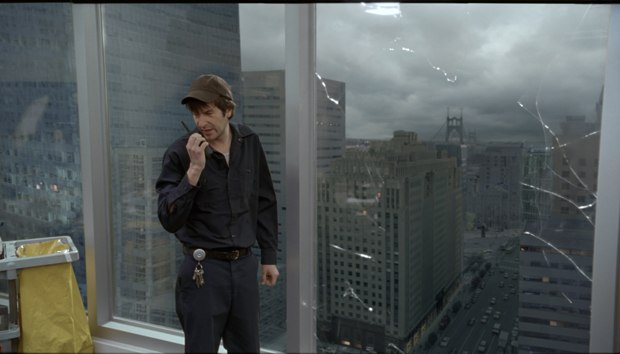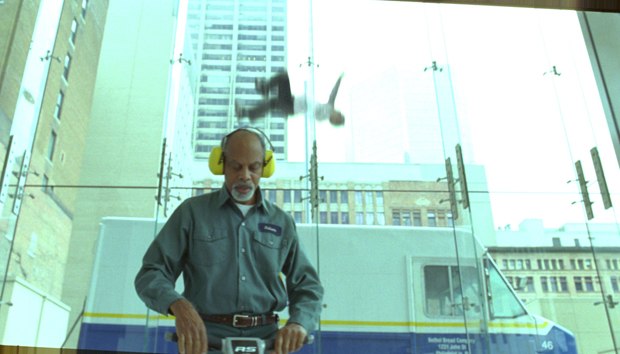Zoic describes what it's like working on the first "Night Chronicles" movie with the Dowdle brothers.
Check out the Devil clips and trailer at AWNtv!
Devil marks the first of M. Night Shyamalan's trilogy of original stories under his "Night Chronicles" production banner at Universal. It's a $20 million supernatural thriller about a group of strangers stuck in an elevator with the Devil in disguise, made by the Dowdle brothers (John directs and Drew produces), who previously did the similarly claustrophobic Quarantine.
Originally CORE was hired to do the vfx, but, when the Toronto studio shut down, Zoic stepped in to handle the 120 vfx shots, under the supervision of Rocco Passionino, with most of the work done by the BC studio.
While there wasn't much interaction with Shyamalan, Passionino had previously worked on Quarantine with the Dowdle brothers, so was quite familiar with their style of filmmaking, especially the use of extremely long takes. In fact, Quarantine was conceived as a single continuous take, as a news crew follows the escalating events surrounding an epidemic.
"John's great and this was somewhat of his first foray into CG," Passionino explains. "So it was a little bit of a learning experience for him, but he's good at articulating where he wants his visual effects to go. It was nice to have someone with a clear vision of what he wanted and be definitive about his choices. CORE had prevised a couple of the sequences, so John had some understanding of how the camera would fly through the shaft in a particular direction. We took over their blocking and fill in the gaps to make it more complete.
The film's opening shot turned out to be the most challenging. More than a minute in length, it begins with a long helicopter descend over the city that lands on the top of a building and starts a dive down through the ventilation system all the way through the upper layers of the building to the elevator shaft and then does a huge dive down through the shaft and comes up from the bottom of the shaft into the lobby where it winds up on a janitor doing some work as a guy falls to his death.
"That was difficult because any time there was a change, it resulted in long render times," adds Passionino. "And a couple of times we had to wing it for visual effects as far as reflections."
The Agatha Christie-like premise of Devil is that five strangers die one by one in the elevator. Not only do their various entrances into the building and the elevator comprise long takes, but also individual flashbacks that reveal their flawed characters. They shot both in Philadelphia (where Shyamalan lives) and Toronto. All of the helicopter shots were done in the former and the ground work in the latter. They used Maya, rendered in mental ray and composited in Nuke.
Anytime you see the elevator in the shaft, it's a full-CG environment. "We did some long pull outs and there are some set extensions as well," Passionino continues. We took a lot of pictures of existing shafts. Our BC office has an elevator there and took photos and we used that as reference. Some of the set piece had the look they wanted so we extended beyond that. We came up with an environment that suited the effect.
"The other interesting thing about the elevator is that two of the walls were mirrored, so because they were shooting on a stage, there were a lot of times when the cameraman and the camera were in greenscreen body suits. And we had to recreate the environment behind and in front of them. It was a case of creating a virtual elevator unit itself, so there were times when we had to connect through that. They also liked stitching together very long camera moves, which they did in Quarantine. They took a lot of those elements and used them here. Now we can digitally erase the cuts for seamless transitions."
As for depicting the Devil, Zoic worked on the design of one Videodrome-like shot in which security guards think they see something creepy on the video monitor; however, the shot was finished by a crew member that's an art designer.
During the climactic showdown between the remaining two characters, Zoic helps reveal the true face of the Devil. "It was like chopping on a person's face and then joining cross dissolves of separate elements to reveal the final look of the Devil," Passionino suggests. "He realizes that he's losing control and then snaps back to the character again."
Another challenge was fixing greenscreen spill. "Because of the fact that it was such a small set, there wasn't a lot of set up for creating lighting on the characters separate from the lighting on the greenscreen," Passionino continues. We roto'd sections of characters and introduced a different color so the spill isn't as evident."
Passionino liked working on the first camera move because the helicopter plate offered an inverted perspective of the city. "They created a heightened unease, which was great fun and had us thinking outside the box," he concludes.
Bill Desowitz is senior editor of AWN & VFXWorld.










